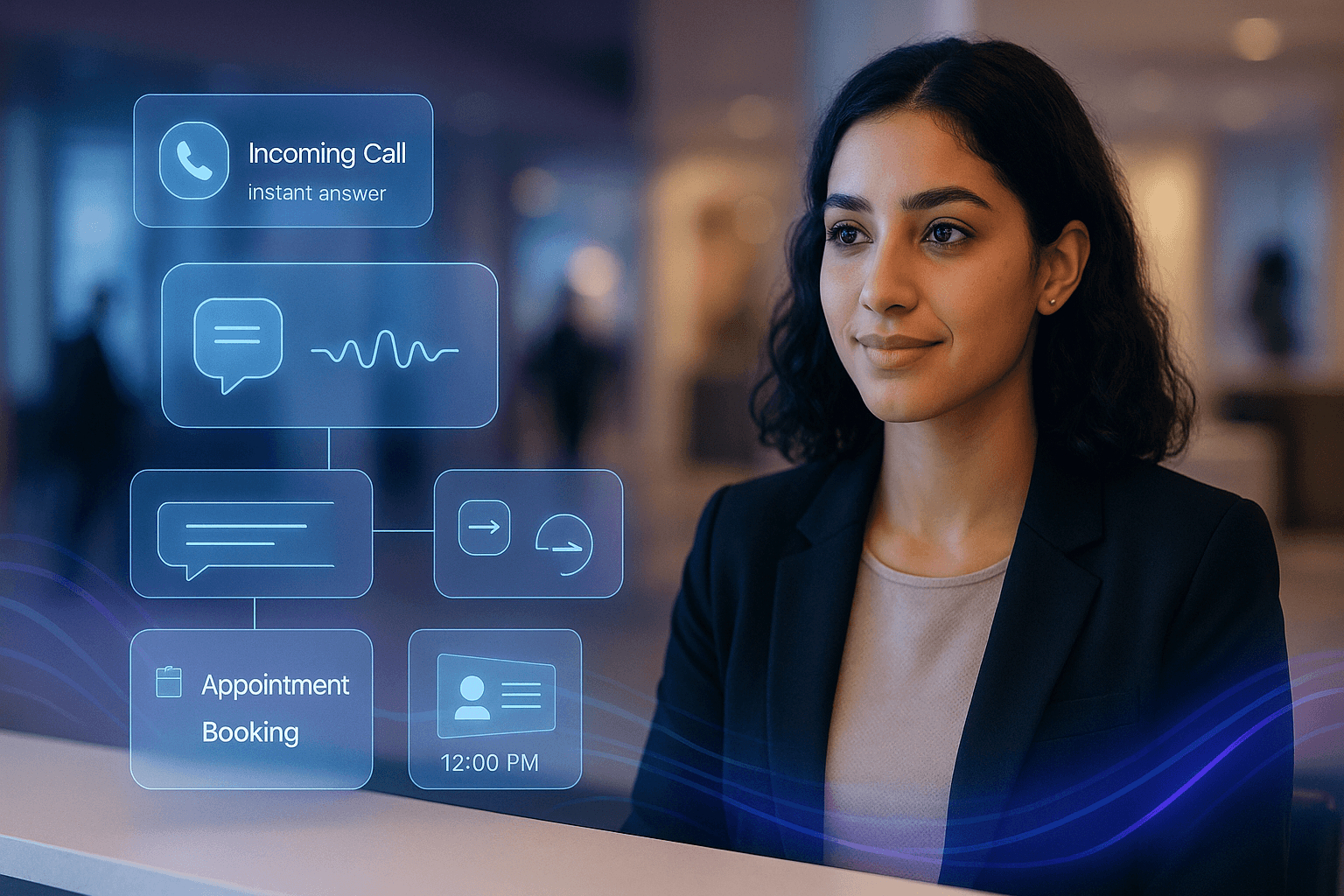Aug 8, 2025
What is Voice AI - Everything you need to know
AI Voicebots for customer service, lead generation and more use cases are on the rise - and they're here to stay. The Complete Guide to Understanding Voice AI Technology in 2025.
4
min read
Voice AI Technology Explained
As businesses race to deliver exceptional customer experiences while managing operational costs, one technology stands out as a game-changer: Voice AI. 🗣️
But what is Voice AI exactly, and why are enterprises increasingly turning to this revolutionary technology?
Let's dive deep into everything you need to know about Voice AI and how it's transforming customer interactions across industries.
TLDR: Voice AI Quick Facts 📋
Voice AI creates synthetic speech that sounds remarkably human-like
Powers everything from virtual assistants to enterprise call center solutions
Can handle thousands of customer interactions simultaneously
Reduces operational costs by up to 70% while improving customer satisfaction
Leading platforms like Leaping AI achieve 85% accuracy rates with proper implementation
What is Voice AI? Understanding the Fundamentals
Voice AI refers to artificial intelligence systems that can understand, process, and generate human-like speech. Unlike traditional text-to-speech technology that produces robotic-sounding voices, modern Voice AI leverages sophisticated machine learning algorithms to create natural, engaging conversations that closely mimic human interaction patterns.
Think of Voice AI as your business's tireless digital representative – one that can handle customer inquiries 24/7, speak multiple languages, and maintain consistent brand messaging across thousands of simultaneous conversations. 🎯
The Evolution of Voice AI Technology
Voice AI didn't emerge overnight. Its development represents decades of research in computer science, linguistics, and artificial intelligence.
Early Days (1950s-1980s): The first speech recognition systems could only handle single words from specific speakers. Bell Labs' "Audrey" system in 1952 could recognize spoken digits, but required careful pronunciation and pauses between words
Rule-Based Systems (1980s-2000s): Systems became more sophisticated but still relied heavily on predetermined rules and limited vocabularies. These worked well for specific domains but couldn't handle natural conversation
Statistical Models (2000s-2010s): The introduction of statistical models and machine learning improved accuracy significantly. Systems could handle larger vocabularies and began to work across different speakers
Deep Learning Revolution (2010s-Present): Neural networks transformed voice AI capabilities. Deep learning models could learn from massive datasets, dramatically improving accuracy and enabling more natural interactions
Current State (2020s): Large language models like GPT and advanced neural networks have created voice AI that can engage in sophisticated conversations, understand context, and provide intelligent responses across virtually any topic
The breakthrough moment came when these technologies converged with cloud computing power, making sophisticated voice AI accessible to businesses of all sizes rather than just tech giants.
How Does Voice AI Technology Actually Work?
Creating effective Voice AI involves several sophisticated steps:
1. Data Collection & Training
Voice AI systems learn from vast datasets of human speech, analyzing patterns in:
Tone and pitch variations
Natural pauses and breathing patterns
Emotional inflections
Contextual speech adjustments
2. Advanced Speech Synthesis
Using neural networks and deep learning, the AI generates speech that includes:
Natural conversation flow
Appropriate emotional responses
Context-aware replies
Proper pronunciation and accent
3. Real-Time Processing
Modern Voice AI platforms like Leaping AI achieve:
Response latency under 2 seconds
Seamless conversation handling
Natural interruption management
Dynamic conversation adaptation
Key Benefits: Why Companies choose Voice AI
💰 Dramatic Cost Savings
Voice AI technology can reduce customer service costs significantly by automating routine interactions.
While human agents handle 30-40 calls daily, AI voice agents can manage unlimited concurrent conversations.
📈 Scalability Without Limits
Unlike traditional call centers that require hiring and training new staff for expansion, Voice AI scales instantly to meet demand spikes – whether it's Black Friday sales or unexpected service outages.
🌍 24/7 Multilingual Support
Voice AI never sleeps, never takes breaks, and can switch between languages seamlessly, providing consistent service quality around the clock.
🎯 Consistency & Compliance
Every interaction follows your exact specifications, ensuring:
Brand voice consistency
Regulatory compliance
Accurate information delivery
Standardized customer experience
Read the comparison of Voice AI vs Human call centers
How to Implement Voice AI Successfully
1. Choose the Right Platform
Select a voice AI solution that offers:
Intuitive conversation design tools
Step-specific prompt configuration
Real-time optimization capabilities
Comprehensive analytics
Leaping AI's drag-and-drop conversation designer enables businesses to build sophisticated AI voice agents without coding, making implementation accessible to teams of all technical levels.
2. Start with High-Impact Use Cases
Begin your Voice AI journey with scenarios that offer immediate ROI:
Order status inquiries
Basic troubleshooting
Account information updates
Product recommendations
3. Monitor and Optimize Continuously
Successful Voice AI deployment requires ongoing refinement.
Look for platforms with:
Detailed conversation analytics
Downloadable transcripts
Performance dashboards
A/B testing capabilities
Real-World Applications Across Industries
📞 Call Center Automation
Transform your call center with AI voice agents that handle:
Customer authentication
Billing inquiries
Technical support
Upselling opportunities
🛍️ Retail Excellence
Enhance customer experience with:
Order tracking updates
Product availability checks
Personalized recommendations
Return processing
👉 More on Voice AI for Retail
📡 Telecommunications
Streamline operations by automating:
Service activation
Plan changes
Outage notifications
Account management
Examples for other popular industries are Voice AI for Travel Companies or Voice AI for Insurance.
Key Players in the Voice AI Space
The voice AI landscape includes established tech giants and innovative startups, each bringing different strengths to the market.
Technology Giants:
Google: Google Assistant and Cloud Speech-to-Text lead in consumer applications and enterprise services
Amazon: Alexa for Business and Connect Voice ID drive significant enterprise adoption
Microsoft: Azure Cognitive Services and Cortana focus on business productivity
Apple: Siri dominates consumer mobile interactions but has limited enterprise presence
Enterprise-Focused Companies:
Nuance: Strong healthcare and customer service focus, recently acquired by Microsoft
Twilio: Programmable voice solutions for developers and businesses
LivePerson: Conversational AI platform with voice capabilities
Specialized Voice AI Providers:
Leaping AI: Advanced voice AI platform specifically designed for customer service and sales, offering human-like interactions with sub-2-second latency
ElevenLabs: High-quality voice synthesis and cloning technology
Hume AI: Emotion-aware AI that can detect and respond to human emotional states
What differentiates the specialized providers is their focus on specific business challenges. While tech giants offer broad platforms, companies like Leaping AI deliver purpose-built solutions that integrate seamlessly into existing business processes with minimal technical complexity.
Addressing Common Concerns About Voice AI
"Will customers accept AI interactions?"
Studies show that customers prioritize quick, accurate service over whether they're speaking to a human or AI. When Voice AI provides efficient solutions, satisfaction rates often match or exceed human interactions.
"What about complex queries?"
Modern voice AI customer support systems seamlessly escalate complex issues to human agents while handling routine inquiries independently. This hybrid approach optimizes both efficiency and customer satisfaction.
"Is Voice AI reliable enough?"
With proper implementation, leading platforms achieve accuracy rates exceeding 85%. Leaping AI's expert prompt engineering and continuous optimization ensure reliable, consistent performance.
The Future of Voice AI in Business
As Voice AI technology continues evolving, we're seeing emerging capabilities like:
Emotional intelligence recognition
Contextual memory across interactions
Predictive customer need identification
Seamless omnichannel integration
Ready to transform Your Customer Experience?
What is Voice AI? It's more than just technology – it's your competitive advantage in delivering exceptional customer experiences while optimizing operational efficiency. As the most advanced AI call center solution available, Leaping AI combines state-of-the-art technology with expert implementation support to ensure your success.
Don't let your competition get ahead. Experience how Leaping AI's voicebots can revolutionize your customer interactions with accuracy rates up to 85% and response times under 2 seconds.
Schedule your personal voice AI demo and discover why leading enterprises trust Leaping AI for their voice AI transformation. 🚀
Related articles
KI Voicebots als digitale Rezeption
Digitale Rezeption mit KI Voicebots von Leaping AI: Ständige Erreichbarkeit, automatische Terminbuchung und 62% Kostenersparnis. So automatisieren Hotels, Praxen und andere Unternehmen ihre Kommunikation mit dem deutschen Marktführer für Voice AI.
KI Telefonassistenten von Leaping AI - so gehts
Schritt-für-Schritt Anleitung zur Implementierung von KI Telefonassistenten mit Leaping AI. Erfahren Sie, wie Sie in vier Wochen Ihren Kundenservice automatisieren, Kosten sparen und die Kundenzufriedenheit steigern.





